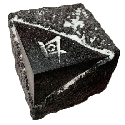The Library and Museum of Freemasonry

Freemasonry is one of the world's oldest secular fraternal societies, a society concerned with moral and spiritual values. Members are taught the rules of Freemasonry by a series of ritual dramas that follow ancient forms and use stonemasons' customs and tools symbolically.
The Library and Museum of Freemasonry houses one of the finest collections of Masonic material in the world. It is open to the public, Monday to Friday, free of charge.
Museum
A changing series of exhibitions portray the history of Freemasonry in England and specific aspects of Masonic life. A tremendous variety of objects including Wedgwood, glass, metal wares - even bed warmers - have, over the centuries, been produced with Masonic decoration.
The Museum's collections are extensive including pottery and porcelain, glassware, silver, furniture and clocks, Masonic jewels and regalia. Items belonging to famous and royal Freemasons including Winston Churchill and Edwards VII are on display together with examples from the Museum's extensive collection of prints and engravings, photographs and ephemera.
Library
The Library is open for reference use. It contains a comprehensive collection of printed books and manuscripts on every facet of Freemasonry in England as well as material on Freemasonry elsewhere in the world and subjects associated with Freemasonry or with mystical and esoteric traditions.
The collections include Mason music, poetry and literature. There are a number of notable examples of fine eighteenth and nineteenth century buildings.
The Library is always pleased to help with historical enquiries by telephone and by post as well as in person and staff can advise about how to use Library resources. However staff cannot undertake extensive research on individual enquiries.
Freemasonry
When, where and why Freemasonry began is not known. It is believed to have originated in England, descending from the craft of the medieval stonemasons.
Lodges of operative masons began to accept non-practicing members who gradually took over whilst groups of men interested in promoting tolerance came together and adopted the stonemasons' tools and customs as allegorical teaching aids.
The earliest record of the making of a Freemason in a non-operative lodge in England is Elias Ashmole at Warrington in 1646.
On 24th June 1717 four London lodges came together at the Goose and Gridiron Ale House in St Paul's Churchyard to form the first Grand Lodge in the world. Grand Lodge became the regulatory body for Freemasonry holding regular meetings and publishing a book of regulations.
A rival Grand Lodge was formed in London in 1751 claiming for itself the title "Ancients Grand Lodge". For 60 years the two Grand Lodges co-existed before a Union between the two was completed in 1813 to form the United Grand Lodge of England.




